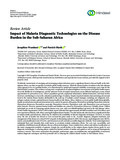Impact of Malaria Diagnostic Technologies on the Disease Burden in the Sub-Saharan Africa
Abstract
Worldwide, transmission of emerging and reemerging malaria infections poses a significant threat to human health in the Sub-Saharan Africa, one that can quickly overwhelm public health resources. While the disease burden of malaria in the Sub-Saharan Africa appears to be on a gradual decline, it is characterized by spatial and temporal variability occasioning a sorry state for the Global South Countries. New evidence on long-term complications of malaria heightens our awareness of its public health impact. Given the likelihood of misdiagnosis, and the unknown levels of malaria transmission across different landscapes, many missed opportunities for prevention occur. Africa’s population growth, unplanned urbanization, habitat destruction, and trans-border travel are contributing to a rise in the calamitous epidemiology of malaria. Despite empirical statistics demonstrating a downward trend in the malaria disease burden attributable to the scale-up of multiple control strategies, including new diagnostic technologies, malaria remains a global threat to human health in Sub-Sahara Africa. Malaria is a severe public health threat globally, despite several advancements and innovations in its control. Six species of the genus Plasmodium including Plasmodium malariae, Plasmodium falciparum, Plasmodium cynomolgi, Plasmodium knowlesi, Plasmodium ovale, and Plasmodium vivax are known to infect humans. However, greatest disease burden and fatalities are caused by Plasmodium falciparum. Globally, about 3 billion individuals are at risk of contracting malaria disease every year, with over 400,000 fatalities reported in the Sub-Saharan Africa. World Health Organization (WHO) 2018 malaria report indicated that approximately 405,000 mortalities and 228 million cases were reported worldwide, with Africa carrying the highest disease burden. Over the last decade, there has been a significant decline in malaria deaths and infections, which may be related to the availability of effective diagnostic techniques. However, in certain areas, the rate of decline has slowed or even reversed the gains made so far. Accurate diagnosis, adequate treatment, and management of the disease are critical WHO-set goals of eliminating malaria by 2030. Microscopy, rapid diagnostic tests (RDTs), nucleic acid amplification tests (NAATs), and biosensors are all currently accessible diagnostic methods. These technologies have substantial flaws and triumphs that could stymie or accelerate malaria eradication efforts. The cost, ease, accessibility, and availability of skilled persons all influence the use of these technologies. These variables have a direct and indirect ramification on the entire management portfolio of patients. Despite the overall decline in the malaria disease burden driven partly by new diagnostic technologies, a sobering pattern marked by limited number of studies and spatial as well as temporal heterogeneity remains a concern. This review summarizes the principle, performance, gaps, accomplishments, and applicability of numerous malaria diagnostic techniques and their potential role in reducing the malaria disease burden in Sub-Saharan Africa.
URI
https://doi.org/10.1155/2022/7324281https://www.hindawi.com/journals/jtm/2022/7324281/
http://ir-library.mmust.ac.ke:8080/xmlui/handle/123456789/2039
Collections
- Gold Collection [1005]

